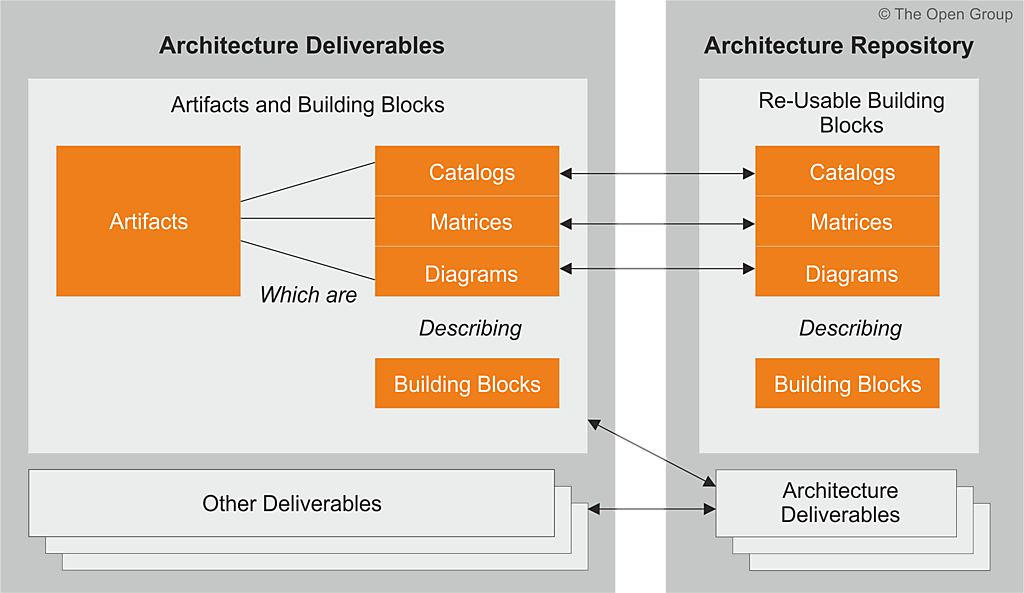Deliverable vs Artifact vs Building Block in TOGAF ADM
Introduction
Enterprise architecture plays a pivotal role in modern organizations, guiding strategic decision-making and ensuring alignment between business goals and IT systems. Within the context of TOGAF (The Open Group Architecture Framework), a structured approach is used to develop and manage enterprise architecture, known as the Architecture Development Method (ADM). This method outlines a comprehensive framework for architects to follow, resulting in the creation of various architectural work products. Among these, Architecture Deliverables and the Architecture Repository hold particular significance.
In this article, we delve into the relationship between Architecture Deliverables and the Architecture Repository within the TOGAF ADM. We explore how these two elements are interconnected, their roles in architecture development, and the benefits they offer to organizations seeking to enhance their architectural capabilities. Understanding this relationship is essential for architects and stakeholders alike as it contributes to effective governance, reuse, and the optimization of architectural assets.
Relationship between Architecture Deliverables and Repository
The relationship between Architecture Deliverables and the Architecture Repository is that Architecture Deliverables often serve as the source of content for the Architecture Repository. When architects create deliverables during the ADM phases, they contain valuable architecture-related information, such as diagrams, specifications, and documentation. These deliverables are typically stored in the Architecture Repository for future reference and reuse.
For example:
- The Architecture Definition Document, which is an Architecture Deliverable, may contain diagrams, descriptions, and specifications of building blocks and architectural components. These elements can be extracted and stored in the Architecture Repository for reuse in other projects.
- The Architecture Repository acts as a central repository where deliverables are cataloged, organized, and made accessible to architects and project teams, ensuring that architecture artifacts are well-managed and available for future use.
Deliverables vs Artifacts vs Building Blocks
In TOGAF (The Open Group Architecture Framework), there are three key categories used to describe different types of architectural work products within the Architecture Development Method (ADM). These categories are:

-
Deliverable:
- Definition: A deliverable is a work product that is contractually specified and is formally reviewed, agreed upon, and signed off by the stakeholders.
- Purpose: Deliverables represent the output of projects, and those deliverables that are in documentation form are typically archived at the completion of a project. They may also be transitioned into an Architecture Repository for reference or as a standard snapshot of the Architecture Landscape at a specific point in time.
- Example: An Architecture Definition Document is a deliverable that documents an Architecture Description.
-
Artifact:
- Definition: An artifact is an architectural work product that describes a specific aspect of the architecture. Artifacts can take the form of catalogs (lists of things), matrices (showing relationships between things), or diagrams (visual representations of things).
- Purpose: Artifacts provide a detailed view of specific architectural elements or aspects. They form the content of the Architecture Repository and are used to document and communicate various aspects of the architecture.
- Example: A requirements catalog, business interaction matrix, or use-case diagram are examples of artifacts.
-
Building Block:
- Definition: A building block represents a component of enterprise capability that can potentially be reused and combined with other building blocks to create architectures and solutions.
- Purpose: Building blocks can be defined at various levels of detail, depending on the stage of architecture development. They may start as high-level abstractions and become more detailed as the architecture work progresses. They shape the specification of Solution Building Blocks (SBBs) and are fundamental in defining the architecture.
- Example: Architecture Building Blocks (ABBs) describe required capabilities, while Solution Building Blocks (SBBs) represent components used to implement those capabilities.
Summary
The relationship between Architecture Deliverables and the Architecture Repository in TOGAF’s ADM is one of synergy and value. Architecture Deliverables, as the output of architectural efforts, encapsulate critical design decisions, specifications, and documentation. They serve as the tangible results of the architecture development process, aiding in communication and decision-making.
The Architecture Repository, on the other hand, acts as a centralized hub for storing, managing, and organizing these deliverables along with other architectural assets, such as building blocks, patterns, and templates. It plays a pivotal role in asset reuse, traceability, governance, and knowledge management.
The interconnectedness between these two elements ensures that valuable architecture-related information is not only captured but also made readily available for future projects and phases. This not only enhances the efficiency of architecture development but also promotes consistency and coherence in an organization’s architectural efforts.
Ultimately, recognizing and harnessing the relationship between Architecture Deliverables and the Architecture Repository empowers organizations to leverage their architectural knowledge effectively, driving informed decision-making and fostering agility in an ever-evolving business landscape.

